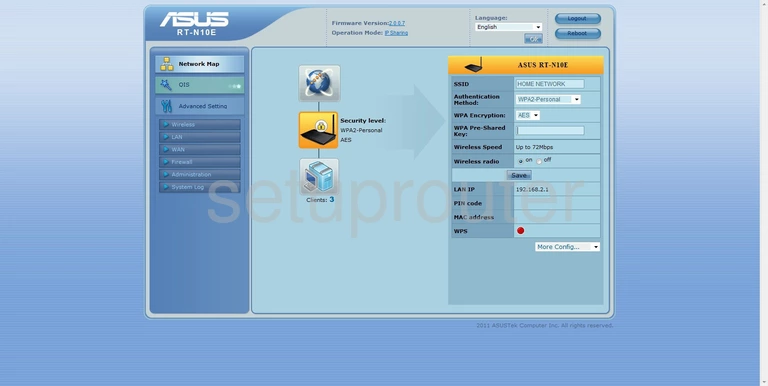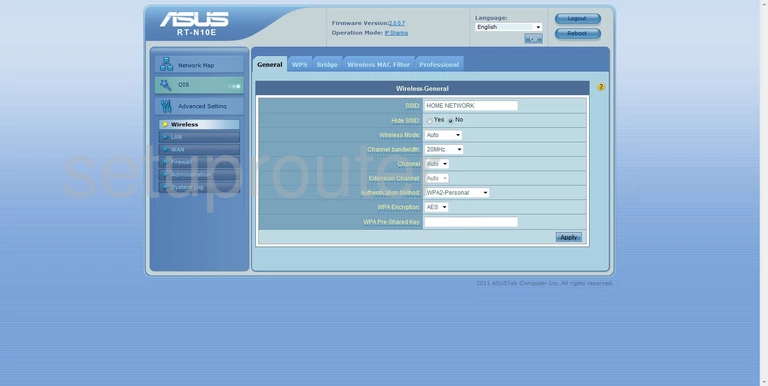The Asus RT-N10E router is considered a wireless router because it offers WiFi connectivity. WiFi, or simply wireless, allows you to connect various devices to your router, such as wireless printers, smart televisions, and WiFi enabled smartphones.
Other Asus RT-N10E Guides
This is the wifi guide for the Asus RT-N10E v2. We also have the following guides for the same router:
- Asus RT-N10E v2 - How to change the IP Address on a Asus RT-N10E router
- Asus RT-N10E v2 - Asus RT-N10E Login Instructions
- Asus RT-N10E v2 - Asus RT-N10E User Manual
- Asus RT-N10E v2 - How to Reset the Asus RT-N10E
- Asus RT-N10E v2 - Asus RT-N10E Screenshots
- Asus RT-N10E v2 - Information About the Asus RT-N10E Router
WiFi Terms
Before we get started there is a little bit of background info that you should be familiar with.
Wireless Name
Your wireless network needs to have a name to uniquely identify it from other wireless networks. If you are not sure what this means we have a guide explaining what a wireless name is that you can read for more information.
Wireless Password
An important part of securing your wireless network is choosing a strong password.
Wireless Channel
Picking a WiFi channel is not always a simple task. Be sure to read about WiFi channels before making the choice.
Encryption
You should almost definitely pick WPA2 for your networks encryption. If you are unsure, be sure to read our WEP vs WPA guide first.
Login To The Asus RT-N10E
To get started configuring the Asus RT-N10E WiFi settings you need to login to your router. If you are already logged in you can skip this step.
To login to the Asus RT-N10E, follow our Asus RT-N10E Login Guide.
Find the WiFi Settings on the Asus RT-N10E
If you followed our login guide above then you should see this screen.

You begin on the Network Map page of the Asus RT-N10Ev2 router. To configure your WiFi settings, click the link on the left side of the page labeled Wireless. Then, at the top of the page, choose General.
Change the WiFi Settings on the Asus RT-N10E

You should now be on a page very similar to the one you see above. First, change your SSID. This is the name you give your network so you can identify it from others around you. This name should be original but without any personal information. For more information on this topic, check out our guide titled Wireless names.
The next thing that you can change is the Hide SSID. By default, No is chosen. This means that other networks can see your network. If you choose Yes, your network will be hidden from other networks, but not from a hacker with the proper tools to scan for networks.
Now, scroll down to the Channel. There are 11 different channels to choose from in the United States. Of those channels, there is only room in the spectrum for three channels that do not overlap each other, channels 1,6, and 11. Choose one of these three channels. If you want more information on why you should only be using these three channels check out our guide titled WiFi channels.
A little farther down is the Authentication Method. What type of security do you want to use. Check out our guide titled WEP vs. WPA for a more detailed description of what the differences are in the security choices. We suggest using WPA2-Personal for your home network.
Next is the WPA Encryption. The router is now asking what type of encryption you want to use with your WPA2-Personal security. We highly recommend using AES. This is the strongest and most secure choice today.
The last thing you must change is the WPA Pre-Shared Key. This is the password you are to use to access your network. This is also used as part of the security method to encrypt your data. This needs to be a strong password of at least 20 characters. It should not contain any personal information or dictionary words. We do recommend using some symbols, numbers, and capital letters in the password. For help in creating a strong password that easily remembered, check out our guide titled How to choose a strong password.
Before exiting be sure to click the Apply button in the lower right corner.
Possible Problems when Changing your WiFi Settings
After making these changes to your router you will almost definitely have to reconnect any previously connected devices. This is usually done at the device itself and not at your computer.
Other Asus RT-N10E Info
Don't forget about our other Asus RT-N10E info that you might be interested in.
This is the wifi guide for the Asus RT-N10E v2. We also have the following guides for the same router:
- Asus RT-N10E v2 - How to change the IP Address on a Asus RT-N10E router
- Asus RT-N10E v2 - Asus RT-N10E Login Instructions
- Asus RT-N10E v2 - Asus RT-N10E User Manual
- Asus RT-N10E v2 - How to Reset the Asus RT-N10E
- Asus RT-N10E v2 - Asus RT-N10E Screenshots
- Asus RT-N10E v2 - Information About the Asus RT-N10E Router